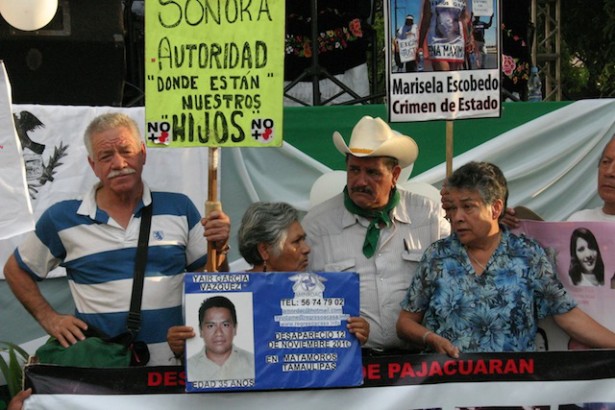
It has been three years since the main square of Cuernavaca, in the state of Morelos, Mexico, filled up with signs displaying the names of those who have died and disappeared during the poorly-named “war against drugs,” which has lead to at least 80,000 deaths and 20,000 disappearances.
It has been three years since the cry of “estamos hasta la madre” — “we’ve had it up to here!” — resonated across Mexico and helped spark the organizing of a victims’ movement. Participants asked for justice and an end to a war that continues to claim the lives of fathers, mothers, sons, daughters, brothers and sisters — destroying families and condemning others to live with the unending longing and hope of finding their loved ones who disappeared.
One of the many victims of this war is Juan Francisco Sicilia, who was murdered just over three years ago on March 27, 2011. Known as “Juanelo,” he was the son of María Ortega and Javier Sicilia, a well-known Mexican poet and journalist. The 24 year old was assassinated alongside six of his friends: Jaime Gabriel Alejos Cadena, Luis Antonio and Julio Cesar Romero Jaime, Álvaro Jaime Aguilar, María del Socorro Estrada Hernández, and Jesús Chávez Vázquez.
The discovery of these seven bodies in Temixco, Morelos, on the morning of March 28, 2011, sparked indignation from various youth groups in the city of Cuernavaca, including former students of the poet Sicilia, and from people who were close to Juanelo and his parents. From this outrage, the youth groups and family friends began organizing a movement for justice that, to this day, still keeps the memories of those who were killed alive.
One month later, on May 4, 2011, the poet Sicilia organized a three-day National March for Peace in which thousands of people marched from Cuernavaca to Mexico City. The mobilization brought together victims of the drug war from all over the country, united in their cry of “estamos hasta la madre.” For the first time in many years, thousands of Mexicans came out to the street to demand justice, peace, and dignity. Many came alone, with pictures of their family members printed on cloths, banners, canvas, and shirts. There they found others who, like them, saw the mobilization as their hope for justice.
That mobilization was the birth of the Movement for Peace with Justice and Dignity, which recently celebrated its three-year anniversary. Since Juanelo’s murder in 2011, this movement has organized two national caravans, bringing together victims and transmitting their stories of pain and survival across Mexico. Victims also met with then-president Felipe Calderón, organized acts of civil resistance, and together began to put a name and face to all the deaths and disappearances.
Three years later, another imposed president rules Mexico: Enrique Peña Nieto of the Institutional Revolutionary Party. The so-called war on drugs continues, and so does the Movement for Peace with Justice and Dignity.
On the movement’s three-year anniversary, the MPJD called together Mexican civil society to “continue organizing, to sow memory and justice.” The movement explains,”one year and three months into Peña Nieto’s administration, the sustained war pushed by the executive power is far from ceasing. It has aggravated the situation for the broadest sectors of Mexican society.”
As examples, the movement points to the murders and aggressions against journalists; the criminalization of the self-defense groups in Michoacán and Guerrero, who are organizing community police to push drug traffickers out of their communities; and the government’s deceitful treatment of families who are seeking reparations for their murdered loved ones under Mexico’s General Law of Victims.
On the three-year anniversary, members of the MPJD came together in public places, filling the streets, plazas and around monuments in order to give dignity and memory to the victims. “We want this plaza to be the public space of encounter for memory, and to begin to rebuild among ourselves the social threads and solidarity that the government seeks to destroy,” the movement explained.
Streets in Cuernavaca named after known repressors, like Boulevard Díaz Ordaz, were changed to “Boulevard March 28th” to honor the victims of the student massacre in 1968, as well as the current victims of the war that Mexico’s government is waging against drug trafficking. This war continues to be a manifestation of international policies, which make Mexico the battleground where Mexicans and Central Americans must pay a high price so that drugs can reach their destination. But increasingly, through actions like those of the Movement for Peace with Justice and Dignity, this battleground is also becoming one where civil society is demanding a future that values human lives above all.
